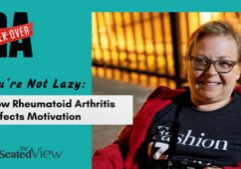Strive to Include
I was going to take a break from writing about accessibility and barriers to same. There was enough of an inaccessibility flurry before my birthday, what with Winners and Metro, the LCBO and Buskerfest and to be honest, I’m tired. Tired of not being able to use stores and spaces the same way my able-bodied brethren can. Tired of having to fight for the right to pay for my purchases. So tired of coming up against not being welcome in so many places. It wears you down. So I decided that my birthday was going to be a turning point. I was going to take a break from this particular for a while and focus on the positive.
A couple of weeks ago, I wrote about revisiting the scenesof the inaccessibility crimes in two locations, Winners and Metro. I wrote about how Metro was having some problems related to barrier-free policies that would support their barrier-free design. More specifically, that the accessible checkouts – the only two with lowered pinpads which were supposed to be staffed at all times – had begun to often be closed. There was also the small matter of the pinpad at the pharmacy being completely inaccessible, likely even by Ontario Building Code standards and that’s saying something.
In that post, I didn’t mention a couple of other annoyances, among them access to the store. My original reason for writing about Metro and contacting them regarding lack of access was the new antitheft gate. The one that was very narrow and required people in wheelchairs to push it open with their bosom. This is also the antitheft gate that was subsequently widened. Furthermore, a policy was made to ensure that the bars on this date would be down during the day when there was more staff available to keep an eye on things. This policy, blessedly, is still in place, allowing full access by people using walkers, wheelchairs or scooters. Of which there is a much higher than average percentage in my neighbourhood, all of whom now have equal access to the store (at least during the day).
Until, that is, the Ontario summer fruits came on the market and the store placed a large display of peaches, pears, and the like in the area, partly blocking the antitheft gate. It is not a problem for me, but my wheelchair has a 16 inch base. Most wheelchairs for adults have an 18 inch base and scooters tend to be at least that wide, as well. They won’t be able to pass through. Thus illustrating a point I make over and over again: you can create a perfectly barrier-free building, but if your staff isn’t trained to consider barriers to accessibility and places displays in front of gates, ramps, elevators and the like, you have accomplished nothing.
The pharmacy pinpad at Metro has also not been changed to an accessible one. I suspect this may be due to the manager to whom I spoke about this issue no longer working in the store.
And while we’re on pinpads, here’s what happened to make me write this post. Yesterday, I went to Metro to buy some groceries. They’re getting new pinpads. Look like really good new pinpads. Fancy, solid ones. Wanna guess how they’re installed by the accessible checkouts?
Yup. Not lowered like the old ones were. Not detachable. Hence not accessible to many customers who use wheelchairs.
This should not have happened. I will almost – but only almost – accept the explanation about following the Ontario Building Code the first time I contact a company regarding barriers to accessibility. As I’ve mentioned before many, many times, the OBC assumes that people with disabilities are like everyone else, just sitting down. They do not make any allowances in height requirements for automatic door buttons pinpads and the like for the fact that disability may also – and often – affect mobility in one’s upper body.
When you do so, you can no longer claim ignorance of the issues. When you do so, you can no longer say ‘oops.’ When you change your accessible pinpads to not being accessible, what you are doing is called purposeful exclusion.
Purposeful exclusion. Doesn’t sound nice, does it? Sounds positively discriminatory, doesn’t it?
Purposeful exclusion and discriminatory are two big concepts. Concepts that have a tendency to make people uncomfortable and squirmy. So let’s put them to the test, shall we? Substitute another group for disability and if it sounds discriminatory, it qualifies.
What would you say if female customers couldn’t pay for prescriptions? Or if customers from a racial minority couldn’t enter the store? Yes, it’s squirmy, but it’s also unacceptable.
As a business, do you really want to purposefully exclude 15% of your customer base? A percentage which is only going to increase as the baby boomers age. A percentage which in this particular neighbourhood is probably much higher. Do you want to discriminate against that many of your customers when they are four other grocery chains in the same neighbourhood? It seems like an unusual approach to doing business. Consider this instead: become the grocery store that is the most accessible of them all. Give that 15% and their family and friends in the neighbourhood a reason to choose you over the competition.
Strive to be barrier-free. Aim to be inclusive. Not because it’s the law (although there is that).
Because it’s the right thing to do.
3 Comments
Read More
Discover what else I've been writing about...
















Wait a minute, if a display is partially blocking an exit gate that is less than 18 inches wide to begin with, how are many adults leaving the store? By the time to add up an adult “width”, plus their groceries, it seems like you would be much wider that 18 inches. Never mind the disability issue, wouldn't this be a fire hazard for all?
Unbelievable. Don't they want the good advertising and linking? Do they really think they will make more money on the sales on those items blocking peoples' path than on all the money that would have been spent by those who were blocked from entering? I mean, just on the sheerly greedily practical point of view they could be coming from.
How about getting ARCH to write them a letter at the very least. This is a case that is right up their alley.
http://www.communitylegalcentre.ca/referrals/legal_clinics.htm
I hate to see you pushed around and disregarded like this. I know you are an amazing advocate but they are not doing the right thing for disabled customers
Annette